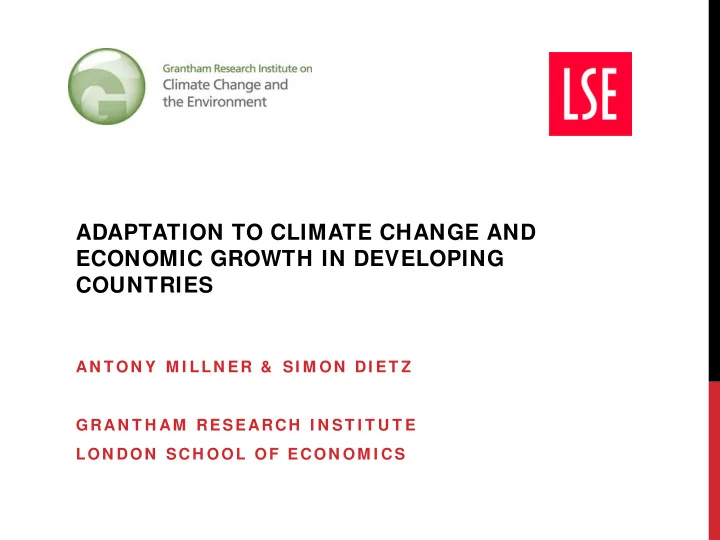

ADAPTATION TO CLIMATE CHANGE AND ECONOMIC GROWTH IN DEVELOPING COUNTRIES AN TON Y M I LLN ER & SI M ON DI ET Z GRAN T H AM RESEARCH I N ST I T U T E LON DON SCH OOL OF ECON OM I CS
STYLIZED FACTS Developing countries, particularly in sub-Saharan Africa, are highly vulnerable to climate change: • Geographic location • High sensitivity (e.g. share of GDP in agriculture) • Low adaptive capacity (e.g. finance, institutions, knowledge) Even if (and that’s a BIG “if”) we get effective mitigation, climate change will occur due to long residence time of atmospheric CO 2 . UNU WIDER, Sept. 2012
THIS PAPER IN A NUTSHELL How should developing countries adapt to climate change? • “Development is the best form of adaptation” – i.e. invest as usual in productive capital • “Development is contingent on adaptation” – i.e. invest to ‘climate-proof’ productive capital Towards adjudicating between these positions, we: • Construct a fully dynamic, easy to interpret, analytical model of adaptation as an investment problem at the macro level • Apply the model empirically to Sub-Saharan Africa, with extensive sensitivity analysis We find that in most contingencies it will be optimal to grow the stock of adaptive capital rapidly over the next 50 years. UNU WIDER, Sept. 2012
MODEL SET-UP Modified Ramsey-Cass-Koopmans growth model (cf. DICE) Two capital stocks • ‘Vulnerable capital’ – productive, but damaged by CC • ‘Adaptive capital’ – unproductive in the absence of CC, but reduces CC damages to vulnerable-capital output Two controls • Consumption/investment in vulnerable capital • Investment in adaptive capital Exogenous temperature change (small developing country/region), population and TFP Convex cost of investment in adaptive capital – captures barriers to adapting quickly such as planning costs, policy delays and corruption UNU WIDER, Sept. 2012
MODEL EQUATIONS Social Planner’s Objective: Vulnerable capital K V : Adaptation costs GDP Depreciation TFP Damages = D(Adaptive capital, Exogenous Temperature) Consumption Adaptive capital K A : Adaptive investment Depreciation UNU WIDER, Sept. 2012
DEPENDENCE OF OPTIMAL INVESTMENT RULE ON CAPITAL (NO ADJUSTMENT COSTS) Proposition 1: Proposition 2: Implications : 1) The strong “adapt through development” position is probably not optimal. 2) Richer economies respond proportionately less to changes in K V but may respond proportionately more to changes in X if the damage reduction effect of a marginal unit of adaptive capital outweighs its effect on the returns to adaptive investment. UNU WIDER, Sept. 2012
FULL DYNAMIC SIMULATIONS FOR SUB- SAHARAN AFRICA Why Sub-Saharan Africa? • Small emitter of carbon: reasonable to assume climate change is exogenous • Highly vulnerable to climate change Close the model: • Choose sensible functional forms for: D(K A ,X) , F(K V ,L) , Q(I) and U(c) • Calibrate model parameters based on IAM literature Note calibration takes into account: 1. Exogenous flow adaptation 2. Relationship between income and damages UNU WIDER, Sept. 2012
BASE CASE : COSTS & BENEFITS Damages as % GDP Investment Costs as % GDP Same order of magnitude as AD-WITCH model. UNU WIDER, Sept. 2012
CLIMATE SENSITIVITY VS. WELFARE WITH AND WITHOUT ADAPTATION UNU WIDER, Sept. 2012
BASE CASE: RATIO OF VULNERABLE TO ADAPTIVE CAPITAL AS FUNCTION OF TIME (BOTH CHOSEN OPTIMALLY) UNU WIDER, Sept. 2012
CAPITAL RATIO FOR LOW ADAPTATION EFFECTIVENESS UNU WIDER, Sept. 2012
SENSITIVITY TO ADJUSTMENT COSTS: DIFFERENCE IN GROWTH RATES OF VULNERABLE AND ADAPTIVE CAPITAL VS. ADJUSTMENT COST PARAMETER First 50 years Second 50 years UNU WIDER, Sept. 2012
SENSITIVITY TO ADAPTATION EFFECTIVENESS WELFARE VS. ADAPTATION EFFECTIVENESS PARAMETER UNU WIDER, Sept. 2012
CONCLUSIONS Developed a simple, transparent model for informing policy discussions. In most plausible cases, we find that it is optimal to grow the stock of adaptive capital rapidly over the next 50 years. This conclusion is robust to changes in the values of all model parameters, except: • i) Effectiveness of adaptation • ii) Initial stock of adaptive capital (which is probably very low) These are the parameters we should focus on pinning down empirically. Our analytics show that simple ad hoc prescriptions are almost certainly wrong: Everything depends on empirical details. Caveats: Uncertainty & Learning, Thresholds, Extreme Events, Institutions, etc., etc. UNU WIDER, Sept. 2012
ADDITIONAL MATERIALS UNU WIDER, Sept. 2012
BASE CASE RESULTS: OPTIMAL CONTROLS Consumption per capita vs. time Adaptive investment per capita vs. time UNU WIDER, Sept. 2012
SENSITIVITY TO ADAPTATION EFFECTIVENESS: (G V – G A ) UNU WIDER, Sept. 2012
SENSITIVITY TO DISCOUNT RATE: CAPITAL RATIO UNU WIDER, Sept. 2012
MODEL PARAMETERS – BASE CASE CALIBRATION UNU WIDER, Sept. 2012
GLOBAL TEMPERATURE TRAJECTORIES UNU WIDER, Sept. 2012
Recommend
More recommend